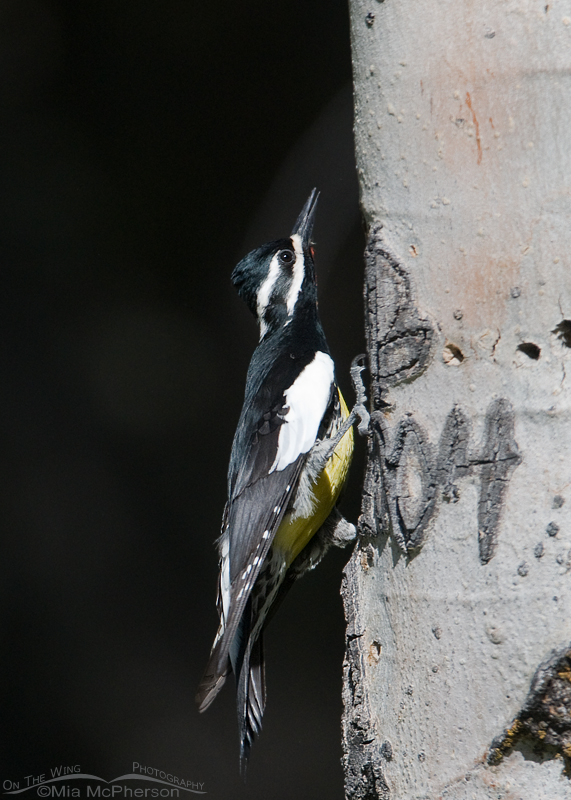 Male Williamson’s Sapsucker just after his first appearance
Male Williamson’s Sapsucker just after his first appearance
Hi there, I am back from another amazing journey and as many of us say “you just never know what you might see” when you are out in nature and this journey produced a few lifers. I count birds as lifers when I photograph them, no matter how cruddy the image might be.
This trip was split between photographing in southwestern Montana and eastern Idaho. To start the trip I slammed my knee into a door as I was closing it which happened before I even left home. So for the first two days I had a gimpy left leg but that didn’t stop me.
Back to the birds…
After I spotted some wrens (more on them soon) darting in and out of cavities in an aspen tree in a sheltered location we pulled over behind some aspen saplings which we used as a blind and started to photograph the wrens. Before long another larger, strikingly colored bird flew in and started climbing up the tree. Seriously I could barely contain myself because in my viewfinder was a gorgeous red, yellow and black colored male Williamson’s Sapsucker that I identified. When he first landed he was checking out a Tree Swallow that was poking its head into one of the many nesting cavities in the aspen and the Tree Swallow soon took off.
Williamson’s Sapsuckers at their nesting tree were lifers for me!
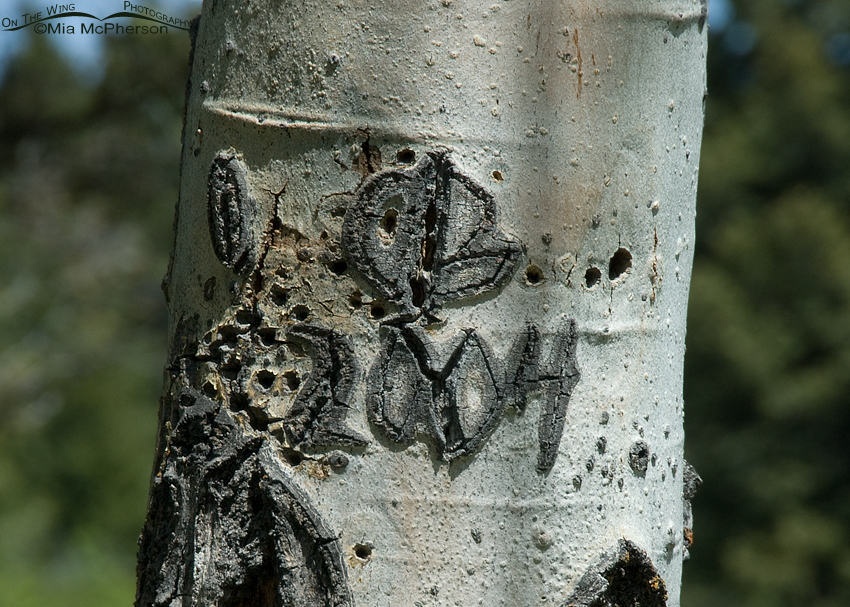 Nesting tree – Aspen with carvings on it
Nesting tree – Aspen with carvings on it
Don’t you just know that the favorite place for this male to land was where someone carved their initials and the year into the bark of the nesting tree?
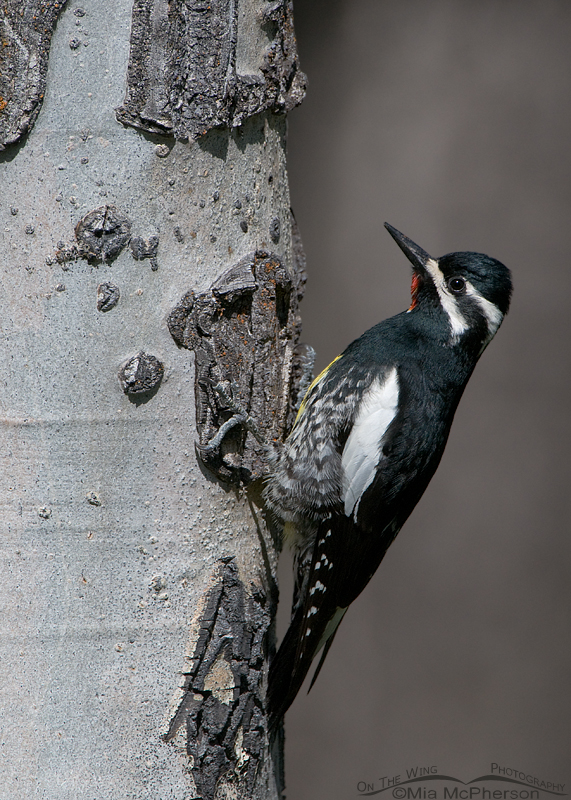 Male Williamson’s Sapsucker on the nesting tree
Male Williamson’s Sapsucker on the nesting tree
Like most woodpeckers and sapsuckers this handsome bird spent time hiding behind the tree but when he came into view he was dazzling. Maybe even stupefyingly knock-your-socks-off drop-dead gorgeous.
Williamson’s Sapsuckers are a secretive species of the Intermountain West and breed in coniferous forests. They have specific habitat needs because of their dependence on sap and phloem. Williamson’s Sapsuckers eat ants that crawl up trees and they also suck sap from the wells they drill in the trees.
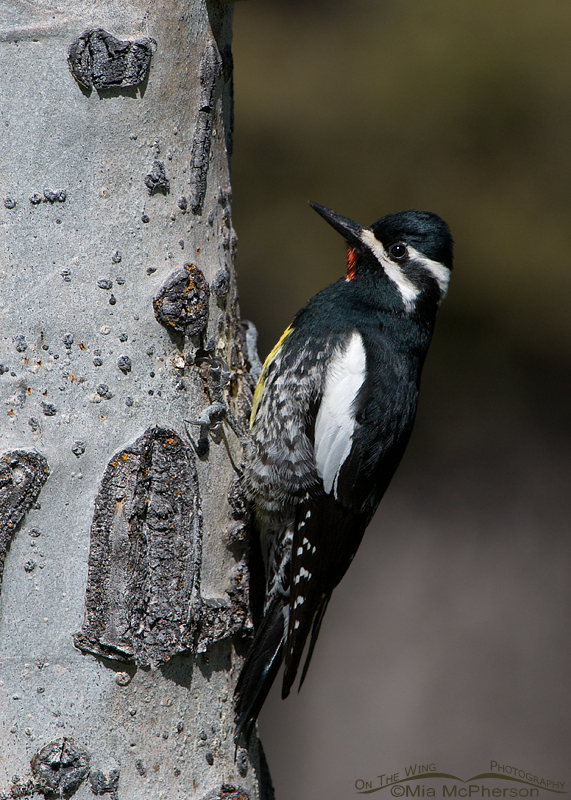 Williamson’s Sapsucker male
Williamson’s Sapsucker male
Unlike other woodpeckers and sapsuckers Williamson’s Sapsucker exhibit remarkable sexual differences in plumage and at first were thought to be two separate species.
John Cassin, a noted ornithologist and taxonomist first described this species as Picus thyroideus in 1851 from two female specimens collected by John G. Bell in California and by 1856 the common name was Black-breasted Woodpecker.
In 1855 John Strong Newberry collected the first male specimen in southern Oregon and named it Williamson’s Woodpecker. Spencer Fullerton Baird renamed the genus Sphyrapicus in 1857. Two other common names during this time period were Baird’s Brown-headed Woodpecker and Cooper’s Round-headed Woodpecker.
In 1873 Henry Wetherbee Henshaw ended the confusion between the two “species” when he observed a mated pair at a nest in Colorado and verified that the two were a single species.
By 1886 the name sapsucker was applied in the first checklist of American Ornithologists’ Union and the common name Williamson was recorded. This species was named after Robert Strong Williamson who was with the expedition with John Strong Newberry when the first male specimen was collected.
What a joy is must have been for early naturalists and ornithologists to explore this country to find, document and name new birds.
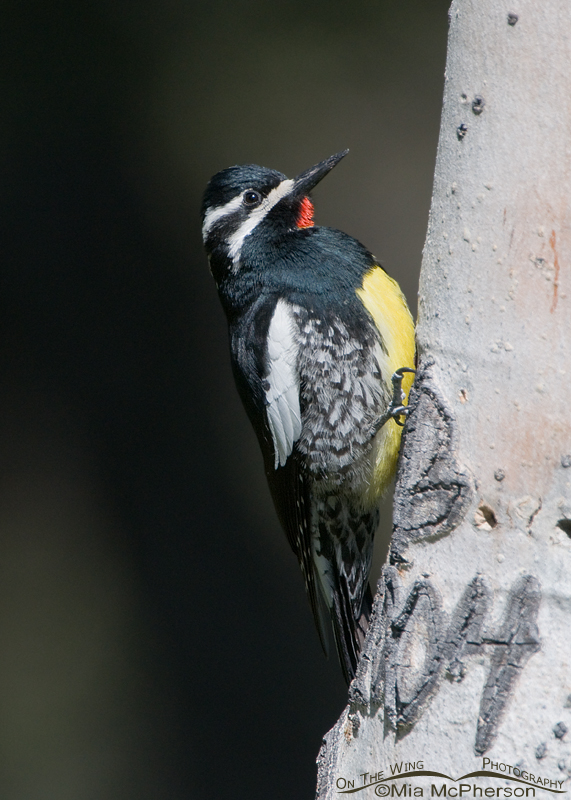 Williamson’s Sapsucker male by carvings in the Aspen
Williamson’s Sapsucker male by carvings in the Aspen
Early studies indicated that only the male excavated the nesting cavity but more recent studies show the females work at excavation too. Quite often the same nesting tree will be used in other nesting seasons and the trees will have several nesting cavities that could be used by secondary cavity nesters including the wrens I mentioned earlier which is why I was drawn to this tree. If I hadn’t paid attention to the wrens I would not have discovered these sapsuckers nesting in the same tree.
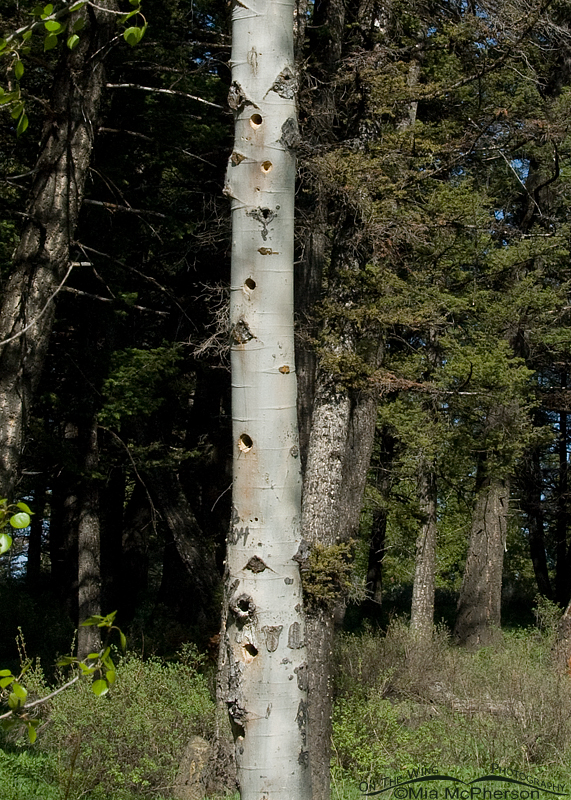 Aspen nesting tree
Aspen nesting tree
This image shows the nesting tree with several cavities and one that has not been completely excavated (second from the top). Williamson’s Sapsuckers prefer live trees that show some sign of fungal infection in the heart wood which makes it easier for them to excavate the nesting cavity. Perhaps the carvings in this tree introduced the fungal infection to this nesting tree? Just guessing.
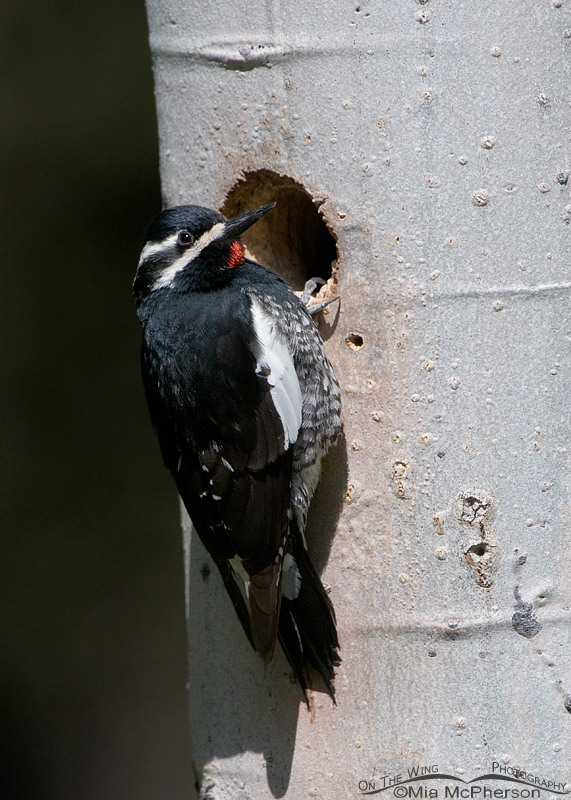 Male Williamson’s Sapsucker at the nesting cavity
Male Williamson’s Sapsucker at the nesting cavity
The male spent all of the time I observed and photographed him the first day outside of the nesting cavity. It was a very busy tree that day with the sapsucker, wrens, Tree Swallows, Mountain Chickadees, Red-breasted Nuthatches and Yellow-rumped Warblers flying in and flitting around. Before flying into the nesting tree I noticed that the sapsucker would give a squeal call.
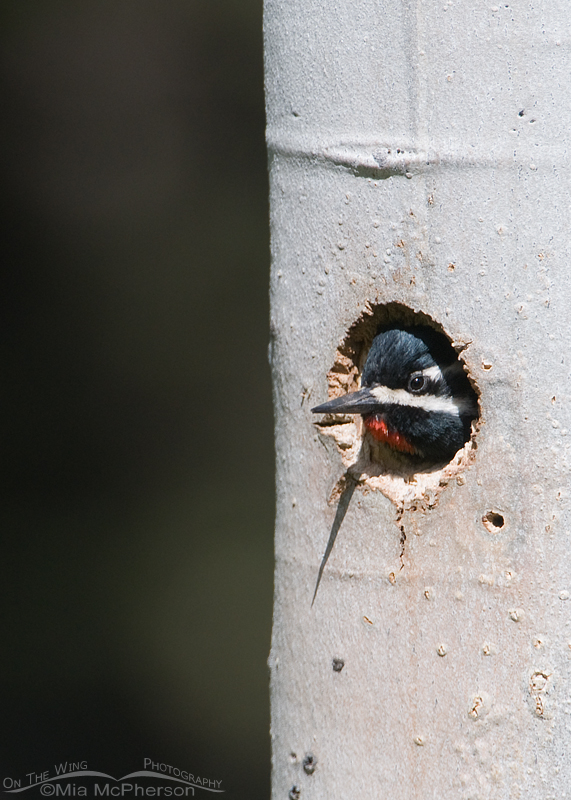 Male Williamson’s Sapsucker in the nesting cavity
Male Williamson’s Sapsucker in the nesting cavity
I went back to the nesting tree for a second morning still using the vehicle and aspen saplings as blinds and on the second morning the male Williamson’s Sapsucker entered the nesting cavity and because it was so quiet in the nesting location I could hear him inside the cavity excavating.
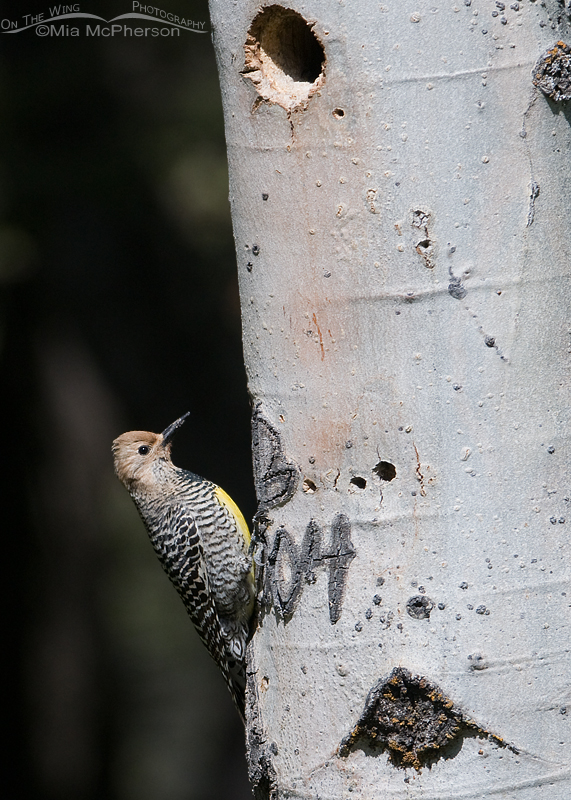 Female Williamson’s Sapsucker just after she flew in
Female Williamson’s Sapsucker just after she flew in
Also on the second day; much to my delight, a female Williamson’s Sapsucker flew in and landed on the nesting tree. Notice how different her plumage is compared to the male? It is no wonder early ornithologists thought they were two different species. She does have some of the yellow on her belly that the male also shows.
Also notice how she landed right where the carvings are in the aspen?
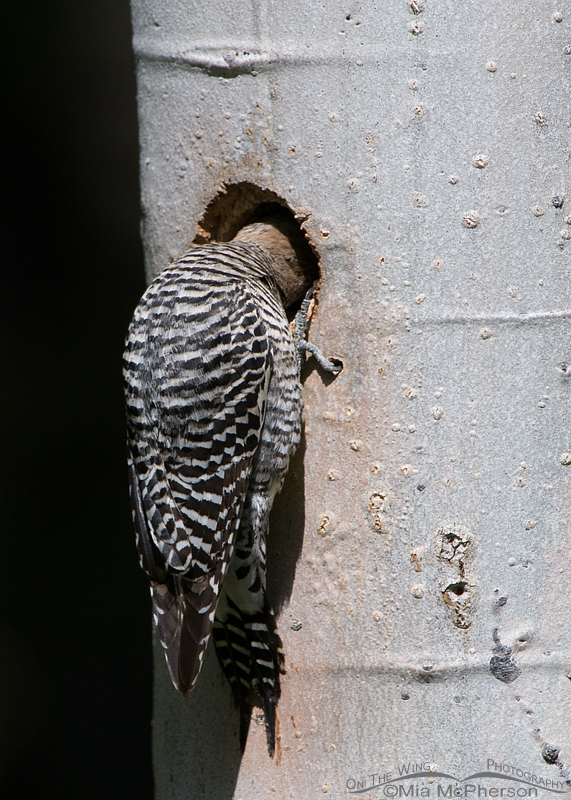 Williamson’s Sapsucker female looking into the nesting cavity
Williamson’s Sapsucker female looking into the nesting cavity
The female checked out the nesting cavity while the male was inside excavating.
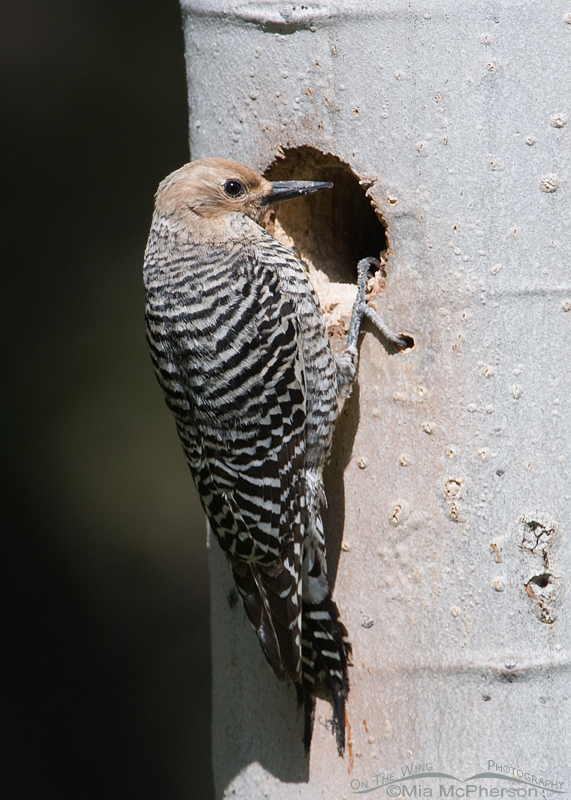 Female Williamson’s Sapsucker checking out the nesting cavity
Female Williamson’s Sapsucker checking out the nesting cavity
And she gave me some great views of her and her plumage while she clung to the outside of the nesting cavity. I would have loved being able to get both the male and female in the same image but they never appeared together.
I stopped because I spotted the wrens that were busy bringing twigs to the nesting tree and because I stopped I got two wonderful lifers in the same location. It pays to be observant and patient.
I also think I need to spend more time in the woods. You can’t photograph woodland birds without being in those trees!
Life is good.
Mia
Click here to see more of my Williamson’s Sapsucker photos plus facts and information about this species.


You mean “lifers” when you see and photogragh them for the FIRST time, correct? It is great to see these two, I have not seen them before nor will I in this area. Even the yellow -breasted sapsuckers which I used to see regularly have evaded me for the past few years. The Williamson’s are beautiful. What perfect holes!
What an incredible tree you found! I can’t begin to imagine the delight and excitement as this bird entered your frame. What a lovely portrait of a species I didn’t even know about. (Oh, and, sorry about your leg! I hope it’s healed up.)
Great stuff Mia! I love that little toe hole they poked in just below the nest cavity to allow for a better perch outside. Saw my first Williamson’s Sapsucker in late-April in eastern Oregon. Such a cool bird!
Beautiful photos! I just photographed a pair yesterday here in CA. But the tree was shaded and had many branches which made it hard to get a clear shot. Such beautiful birds!
What an absolutely gorgeous birds! How exciting and rewarding for you to watch and record these behaviors. Very nice.
Fantastic series of photos!
Wonderful series and terrific photos. What a wonderful find!
Beautiful birds and interesting info — thanks Mia.
Gorgeous bird!
Holy CRAP girl I bet your heart was just pounding and probably still is as you look at these images. Congrats and so thrilled you shared them with us!
Oh my. If I had been present I suspect my own squeee call would have been added to the male’s ‘squeal call’. What an incredible experience. And I am in awe at the accuracy of those nesting holes. And the beauty. And…
How exciting! A great post, Mia. Fantastic photos.
And good for you for not giving out nesting locations.
Thank you so much for the images and information about this gorgeous bird.
Mary
Hi!
You lift my spirits this AM with all these beautiful photo’s of the Sapsuckers! I can not get a good photo of my hummers so far! Darn. Lots of great pics of flowers and my male skinks, tho. I can even get my fingers close to them now! They sure love bananas! Have a great day. Thank you for being such a great one with photo’s and Info!
Wow!!!!!
Those are AMAZING photos!!!
I love them.
Great Photos and what a wonderful experience!
Wonderful Mia!
Wow! Great post. Congrats on the lifer and the great images.